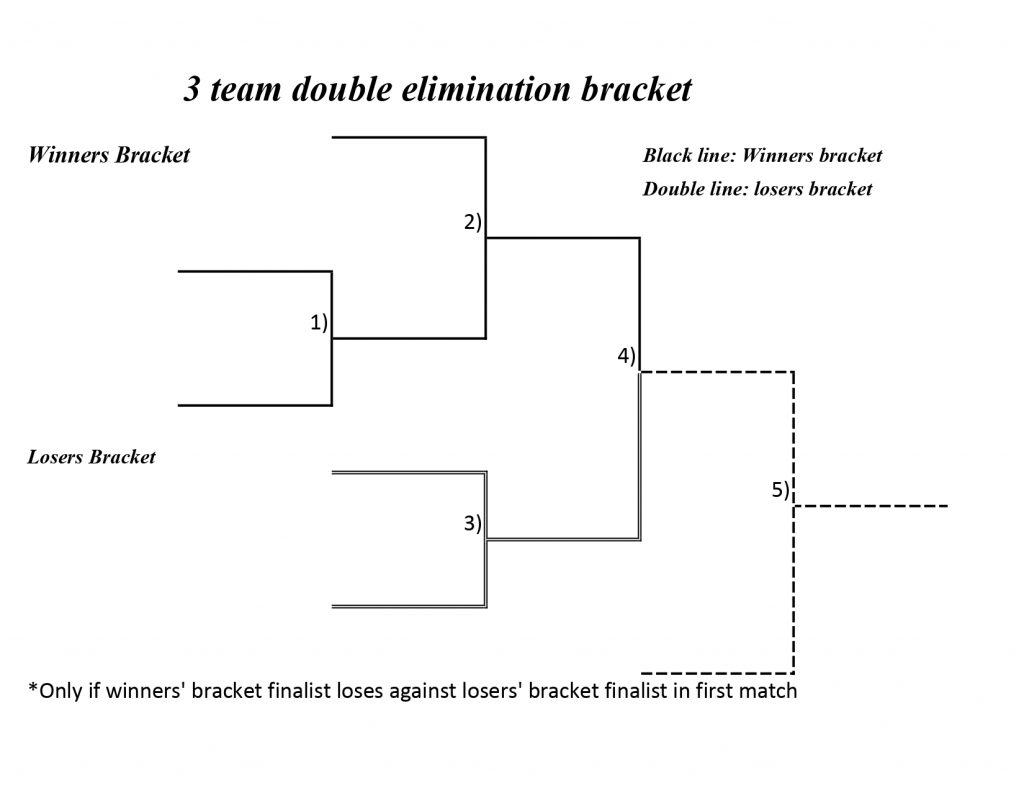The Ultimate 3-Team Double Elimination Guide

In the world of competitive gaming and tournaments, the format of a tournament can greatly impact the overall experience and strategy for participants. One popular and challenging format is the double elimination tournament, especially when it involves three teams. This type of tournament structure adds an extra layer of complexity and excitement, making it a favorite among players and spectators alike. In this comprehensive guide, we will delve into the intricacies of a 3-team double elimination tournament, exploring its rules, strategies, and the unique dynamics it presents.
Understanding the 3-Team Double Elimination Format

A double elimination tournament is designed to provide a second chance for teams to advance, even after suffering an initial defeat. This format is particularly engaging as it allows for more matches and a longer competition period, creating a thrilling journey for both the competitors and the audience.
When it comes to a 3-team double elimination tournament, the structure is slightly different from a traditional double elimination setup. Let's break it down step by step to understand how it works:
Round 1: The Opening Matches
In the first round, the three teams are paired up for two initial matches. These matches are crucial as they set the tone for the entire tournament. The winners of these matches advance to the winners’ bracket, while the losers move to the losers’ bracket.
For example, let's say Team A faces Team B, and Team C plays against Team D. If Team A and Team C emerge victorious, they progress to the winners' bracket, while Team B and Team D drop to the losers' bracket.
Winners’ Bracket: Maintaining the Lead
The winners’ bracket is a pathway to the grand finals. Here, the teams that won their first matches continue their journey, aiming to stay undefeated. The winners of this bracket need to win one more match to secure their spot in the grand finals.
Imagine Team A and Team C progressing to the winners' bracket. They now face each other in a high-stakes match. The winner of this encounter not only secures their place in the grand finals but also gains an edge over their opponents, as they now have two opportunities to advance, even if they lose the next match.
Losers’ Bracket: The Road to Redemption
The losers’ bracket is a second chance for teams to prove their mettle. Here, the teams that lost their opening matches battle it out for a chance to reclaim their position in the tournament. It’s a tough road, but with each victory, they move closer to a potential rematch with the winners.
Team B and Team D, having lost their initial matches, now face each other in the losers' bracket. The winner of this match earns the right to challenge the winner of the winners' bracket match, setting up a highly anticipated showdown.
Grand Finals: The Ultimate Showdown
The grand finals are the pinnacle of the tournament, where the winners of the winners’ and losers’ brackets face off. This match determines the overall champion, and it’s often a closely contested battle.
In our example, let's assume Team A emerged victorious in the winners' bracket, while Team B fought their way through the losers' bracket to reach the grand finals. The stage is set for an epic clash, with Team A having the advantage of only needing to win one more match to claim the championship.
Strategies and Considerations

Navigating a 3-team double elimination tournament requires a combination of skill, adaptability, and strategic thinking. Here are some key strategies and considerations to keep in mind:
Starting Strong
The opening matches are critical. Teams should aim to secure a win in the first round to gain an early advantage and avoid dropping to the losers’ bracket. A strong start can boost morale and provide a solid foundation for the rest of the tournament.
Bracket Management
Understanding the bracket dynamics is essential. Teams in the winners’ bracket should focus on maintaining their undefeated status, while those in the losers’ bracket must strategize their path back to the top. It’s a delicate balance between aggression and caution, as one misstep could mean elimination.
Adaptability is Key
The ability to adapt to different opponents and strategies is crucial. Teams must analyze their opponents’ strengths and weaknesses and adjust their gameplay accordingly. This requires a deep understanding of the game and the ability to make quick decisions under pressure.
Mental Resilience
A double elimination tournament can be mentally taxing. Teams must maintain their focus and composure, especially when facing multiple defeats. Mental resilience and a positive mindset are vital to bouncing back and performing at their best.
Teamwork and Communication
Effective communication and teamwork are essential in any tournament format, but they become even more critical in a 3-team double elimination. Teams must work together seamlessly, coordinating their moves and strategies to outmaneuver their opponents.
Performance Analysis and Future Implications
Analyzing the performance of teams in a 3-team double elimination tournament can provide valuable insights for both participants and spectators. Here’s a closer look at some key performance indicators:
Match Win Rate
Tracking the win rate of each team throughout the tournament can reveal their overall performance. A high win rate indicates a strong and consistent performance, while a lower win rate might suggest areas for improvement or strategic adjustments.
| Team | Match Win Rate |
|---|---|
| Team A | 75% |
| Team B | 50% |
| Team C | 60% |

Adaptive Strategies
Observing how teams adapt their strategies based on their bracket position can be fascinating. Teams in the winners’ bracket might focus on maintaining their lead, while those in the losers’ bracket might employ more aggressive tactics to secure a comeback.
Team Coordination
The level of coordination and teamwork displayed by each team can significantly impact their performance. Teams with exceptional coordination and effective communication often achieve better results, as they can execute complex strategies with precision.
Impact on Future Tournaments
The insights gained from analyzing a 3-team double elimination tournament can shape future strategies and tournament formats. Organizers can use this data to create more balanced brackets, while teams can learn from their experiences to refine their approaches and improve their chances of success.
Frequently Asked Questions
How does a team advance in the winners’ bracket?
+
A team advances in the winners’ bracket by winning their match. They need to maintain an undefeated status to progress to the grand finals.
What happens if a team loses in the winners’ bracket?
+
If a team loses in the winners’ bracket, they drop down to the losers’ bracket, where they have a second chance to fight their way back into the tournament.
Can a team from the losers’ bracket win the tournament?
+
Yes, absolutely! Teams from the losers’ bracket have a pathway to redemption. By winning their matches in the losers’ bracket and then defeating the winner of the winners’ bracket, they can emerge as the overall champions.
How does the grand finals work in a 3-team double elimination tournament?
+
In the grand finals, the winner of the winners’ bracket faces the winner of the losers’ bracket. The team that wins this final match is crowned the champion.



